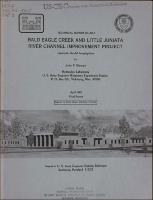Please use this identifier to cite or link to this item:
https://hdl.handle.net/11681/13602Full metadata record
| DC Field | Value | Language |
|---|---|---|
| dc.contributor | United States. Army. Corps of Engineers. Baltimore District | - |
| dc.contributor.author | George, John F. | - |
| dc.date.accessioned | 2016-08-18T19:14:32Z | - |
| dc.date.available | 2016-08-18T19:14:32Z | - |
| dc.date.issued | 1980-04 | - |
| dc.identifier.uri | http://hdl.handle.net/11681/13602 | - |
| dc.description | Technical Report | - |
| dc.description | Abstract: Tests were conducted on a 1:25-scale model of Bald Eagle Creek and the Little Juniata River to determine the adequacy of proposed channel improvements included in the Tyrone Flood Control Project. The model reproduced approximately 5,340 ft of Bald Eagle Creek which consisted of Westvaco Dam, the transition immediately downstream, the high-velocity channel with superelevated curves, the stilling basin, and approximately 800 ft of the Little Juniata River including its confluence with Bald Eagle Creek. Unsymmetrical approach conditions upstream of Westvaco Dam resulted in unequal flow distribution across the dam. This caused cross waves to develop in the transition section downstream of Westvaco Dam. Modification of the left slope of the existing topography and placement of a curved wing wall on the right abutment of the dam improved the flow distribution across the dam and reduced the cross waves in the transition section immediately downstream. Extension of the right vertical wall of the transition 290 ft upstream with the slope modification in place also improved the flow distribution across the dam and reduced the cross waves in the transition. Flow conditions were satisfactory throughout the high-velocity channel. Wall heights were adequate to contain the design discharge of 13,400 cfs. Unsatisfactory flow conditions were observed in the Bald Eagle Creek stilling basin and at its confluence with the Little Juniata River for both design flood conditions of 13,400 cfs in Bald Eagle Creek with no flow in the Little Juniata River, and 29,300 cfs in the Little Juniata River with 11,000 cfs in Bald Eagle Creek. The confluence was modified to provide satisfactory flow conditions downstream of the confluence for both design flood conditions. However, unsatisfactory flow conditions persisted in the stilling basin during flood flows in the Little Juniata River, regardless of modifications tested because of the excessive tailwater depths present in the stilling basin. The optimum riprap and gabion protection plans were determined for the bank slopes in the Little Juniata River. | - |
| dc.publisher | Hydraulics Laboratory (U.S.) | - |
| dc.publisher | Engineer Research and Development Center (U.S.) | - |
| dc.relation | http://acwc.sdp.sirsi.net/client/en_US/search/asset/1033525 | - |
| dc.relation.ispartofseries | Technical report (U.S. Army Engineer Waterways Experiment Station) ; HL-80-5. | - |
| dc.rights | Approved for public release; distribution is unlimited. | - |
| dc.source | This Digital Resource was created from scans of the Print Resource | - |
| dc.subject | Bald Eagle Creek | - |
| dc.subject | Channel flow | - |
| dc.subject | Channel improvement | - |
| dc.subject | Hydraulic models | - |
| dc.subject | Little Juniata River | - |
| dc.subject | Water resources | - |
| dc.subject | Tyrone Flood Control Project | - |
| dc.subject | Pennsylvania | - |
| dc.title | Bald Eagle Creek and Little Juniata River channel improvement project : hydraulic model investigation | - |
| dc.type | Report | en_US |
| Appears in Collections: | Technical Report | |
Files in This Item:
| File | Description | Size | Format | |
|---|---|---|---|---|
| TR-HL-80-5.pdf | 7.59 MB | Adobe PDF |  View/Open |